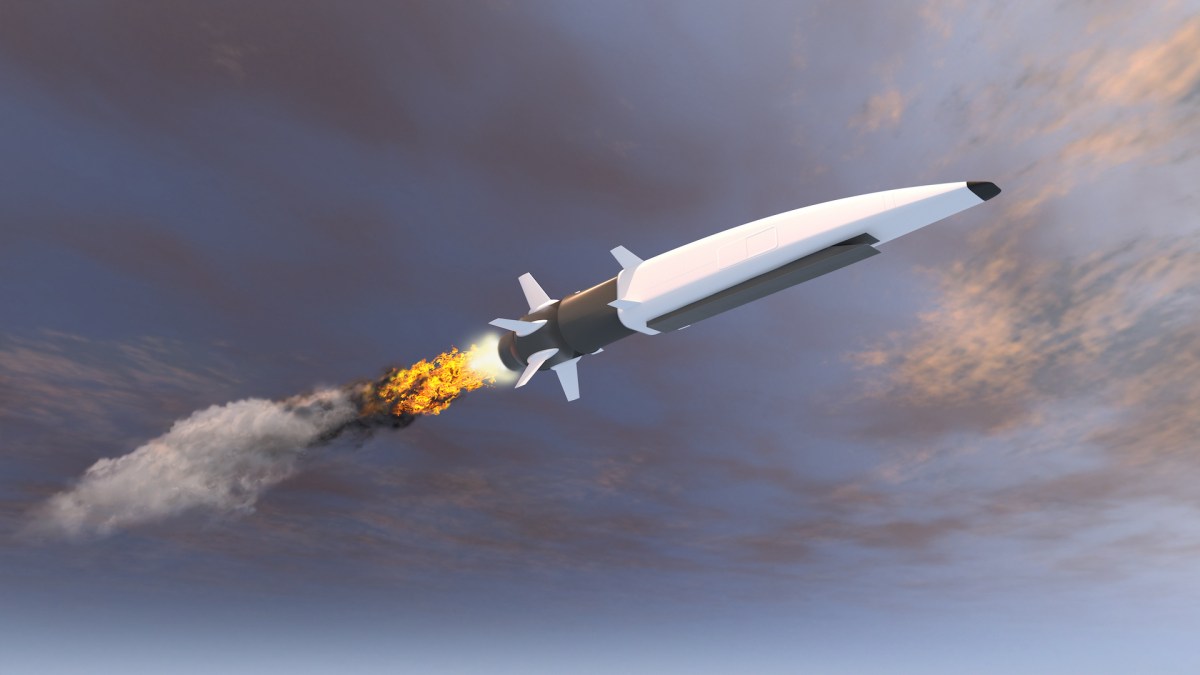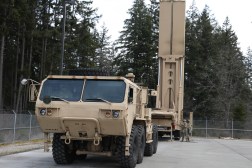Physics and cost are shaping Pentagon’s hypersonics paths

After an unsuccesful all-up-round prototype test in March, the Air Force decided to scrap its procurement plans for the Air-launched Rapid Response Weapon (ARRW) and focus its efforts on another weapon — the Hypersonic Attack Cruise Missile (HACM). While both of the programs are hypersonics efforts, experts noted that there are key differences between the two types of systems that point to how each of the services are prioritizing their procurement efforts to match their operational requirements.
Hypersonic systems are able to travel faster than Mach 5, or five times the speed of sound. Their high velocity speed coupled with their ability to maneuver as they fly through the atmosphere make hypersonic missiles much harder to detect and intercept when compared to a traditional ballistic missile that travels a predictable flight path.
These capabilities are a top modernization priority for the Pentagon, and the outcome of the department’s technology efforts will affect how well the U.S. military stacks up against advanced adversaries, such as China and Russia, in the future.
The Pentagon is pursuing multiple types of hypersonic weapons — namely, boost-glide systems and cruise missiles — that have unique characteristics.
‘Think of it in terms of energy’
The Defense Department has spent years and billions of dollars — including roughly $4.5 billion approved in the fiscal 2023 budget — researching and developing hypersonics as the United States tries to catch up with China and Russia’s matured programs.
Efforts have focused on operationalizing two types of systems: boost-glide missiles and cruise missiles. While the Army and Navy’s efforts have focused on boost-glide capabilities, the Air Force was pursuing air-launched variants of both, as ARRW is a boost-glide system while HACM is an air-breathing cruise missile.
Mark Lewis, who recently served as director of NDIA’s Emerging Technologies Institute and was recently hired to be CEO of the Purdue Applied Research Institute, said that while it would be ideal to have both types of weapon, it makes sense to prioritize a cruise missile like HACM for tactical missions that the Air Force would conduct.
“If you look at the two, I like to think of it in terms of energy,” said Lewis, who previously served as acting deputy undersecretary of defense for research and engineering and director of defense research and engineering for modernization at the Pentagon.
Boost-glide missiles like ARRW are first launched from a rocket booster that gives it enough energy to reach hypersonic speeds and then glide along the atmosphere without using additional propulsion, whereas cruise missiles are powered by air-breathing jet engines — also called scramjets — that pull in oxygen from the atmosphere to achieve hypersonic flight, he explained.
“In the boost glider, I’m putting all of my energy up front,” Lewis told DefenseScoop. “With the air breather, I’m releasing my energy as I fly through the atmosphere almost continuously. So it’s really about energy management.”
Both types of systems are an incredibly difficult feat of physics to get correct for different reasons, said Joe Jewell, assistant professor at Purdue University’s School of Aeronautics and Astronautics.
“The technology to do that boost glide, the main thing you need is you need to deal with the thermal load, you need to accelerate it up to the speed that it’s designed to operate at — and that’s usually done with a separate rocket booster — and then you need to intelligently use that energy you’ve got … and bleed that off in an intelligent way such that you don’t slow down your maneuvering vehicle too much before it reaches its objective,” Jewell told DefenseScoop.
The limitation of boost glide hypersonics like ARRW is that the energy the system gets during the initial thrust of energy from the rocket engine is all it will ever have to achieve high speeds, he said.
But cruise missile hypersonic missiles can add thrust or energy to their flight profile as they maneuver along their flight path, due to the air-breathing engine, he added.
“In an air-breathing engine, you can actually get some of the energy back. Maybe you can accelerate through your flight path,” Jewell said. “It just adds another dimension to how maneuverable, and therefore survivable, the vehicle is at the cost of complexity and expense.”
However, in choosing to move forward with an air-breathing hypersonic weapon over a much more fully developed rocket-launched variant, the Air Force has picked the more complex of the two to develop, he added.
The air moving through a scramjet engine flows at supersonic speeds of at least Mach 1, which makes ignition very challenging, making it more difficult to design the physical vehicle, he explained.
“It’s only designed to work over this limited range of Mach numbers. You have to get to that Mach number before you can even test it, so that’s hard. And then you have to keep it lit,” he said, noting that it’s been compared to “keeping a match lit in a hurricane.”
Lewis noted that the different propulsion methods of the two variants affect what they have to carry. Because a boost-glide hypersonic weapon uses a rocket engine to take off, it needs to carry a liquid oxidizer that can ignite its fuel. An air-breathing hypersonic weapon doesn’t need a liquid oxidizer because it uses oxygen pulled in from the atmosphere.
“If you do things right, all things being equal, the air breather can go further on a tank of gas because the air breather’s tank of gas is just the fuel,” Lewis said. “Whereas the rocket’s tank of gas is the fuel, plus some oxidizer with which to burn the fuel.”
The price tag matters too
The differences between boost glide and air-breathing hypersonic missiles, as well as how the Defense Department prioritizes them, also comes down to cost management, Lewis noted.
“For a boost glider, we basically know how to build rocket engines. … Yeah you’ve got to develop maybe a new booster, but we know how to do that. So you have to invest all the technology in the weapon itself,” he said. “But with the air breather, you’ve got a different set of challenges because you’ve got to figure out how to build the engine … and then it has to integrate exquisitely with the rest of the vehicle.”
Until recently, the Air Force intended to buy both types of hypersonic missiles that could be launched from the service’s aircraft. For fiscal 2024, the service is requesting $381.5 million for research and development of HACM, which is being built by Raytheon. The Air Force also requested around $150 million for R&D of the Lockheed Martin-made ARRW. However, it plans to scrap its procurement plans for ARRW once it completes its planned prototyping program in fiscal 2024.
HACM is “compatible with more of our aircraft and it will give us more combat capability overall,” Secretary of the Air Force Kendall told lawmakers last month while testifying to the House Appropriations Committee’s defense subcommittee.
Lewis agreed, noting that boost-glide hypersonics are generally much larger than air breathers and that it’s very difficult to scale the systems down to fit on an aircraft.
“Because they’re not carrying their oxygen with them, an air breather is packaged batter,” Lewis said. “You can build a hypersonic cruise missile that’s basically in a smaller package than the corresponding tactical boost glider. That means you can get more of them on the airplane, you can get more in the bomb bay, you get a deeper magazine.”
Even though the air-breathing hypersonics are less developed, the belief is that they will be less expensive per round than boost-glide variations, Lewis said. While there are costs associated with research, development and associated technologies of an air-breathing system, it is a much less complex piece of machinery once the vehicle’s design is perfected, he said.
“They’re really just ducts, and you’re squirting fuel in and igniting it and producing thrust that way. So they can be relatively simple devices,” he said. “The devil, of course, is in the details, but advanced manufacturing capabilities — things like additive manufacturing, as just one example — reduce the cost of manufacturing.”
As the Air Force prioritizes HACM, both the Army and Navy are on the cusp of fielding their own hypersonic weapons — the Long-Range Hypersonic Weapon (LRHW) and the Conventional Prompt Strike (CPS), respectively. Both are boost-glide hypersonic missiles, although the Army’s will be ground-launched and the Navy’s will be fired from destroyers and submarines at sea.
The Army is looking for $901 to fund further development of the LRHW. The service deployed the first platform at Joint Base Lewis-McChord in Washington in March for training and mission rehearsal, and by the end of 2023 plans to have the first battery as part of the 1st Multi-Domain Task Force.
Meanwhile, the Navy — which has been working with the Army on a common hypersonic glide body — plans to have CPS integrated into Zumwalt-class destroyers by fiscal 2025.
The Navy is currently asking Congress for $901 million in fiscal 2024 for research, development, test and evaluation of the CPS. The sea service also wants to buy eight initial “all-up rounds” and canisters for the weapon in 2024, with a plan to spend upwards of $50 million per round, on average, over the next five years to procure dozens of the missiles.
Undersectary of Defense for Aquisition and Sustainment William LaPlante said the Pentagon needs to do more to lower the price tag of its hypersonic weapons.
“We’re just for the first time as a country getting to production of hypersonics, and not surprisingly the average unit cost is … higher than we want it to be and we need to bring it down,” LaPlante told DefenseScoop at the Navy League’s Sea-Air-Space conference last week.
For hypersonics writ large, officials should shoot for a per round price tag of less than $10 million, he suggested.
“I would think an average procurement unit cost of in the single digit millions is where we should aim for it. And we’re actually looking at some that are as low as $3 million an all-up round. That’s where we want to be,” LaPlante said.
“In general, we’re looking at concepts for cruise missiles and we would like to get it under 10 — ideally as low as $3 million,” he added. “I’m not going to name the system [that might be as low as $3 million per round] because it’s still pre-decisional. But the more important point rather than what that system is, is that we want to get that price point down under in the single digits.”
In addition to acquiring CPS for its ships, the Navy is also looking to equip its aircraft carrier-based fighter jets with a Hypersonic Air Launched Offensive (HALO) Anti-Surface weapon, and recently awarded two contracts to Raytheon Missiles and Defense and Lockheed Martin to pursue the technology. The HALO, which despite its name might not actually fly at hypersonic speeds, may be a cruise missile rather than a boost-glide system because of the size constraints associated with carrier air wing operations.
The preferences between each of the services is reflective of their mission requirements, Lewis said. Both the LRHW and CPS are larger weapons that are difficult to scale down to a size that can fit onto an aircraft due to their physics, he said.
“At the large scale I’d say, ‘Hey if I want to build something big and hypersonic, I probably want to go with a rocket-boost glide,’” Lewis said. “But if I want to build something tactical that fits on an airplane, then right now I would argue the air breather is the more mature technology.”






